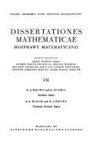Sasaki–Einstein结构的投影几何及其紧致化
IF 0.8
3区 数学
Q1 MATHEMATICS
引用次数: 7
摘要
我们证明了Sasaki结构的标准定义在射影微分几何方面具有优雅和简化的解释。对于Sasaki-Einstein结构,我们使用投影几何来将这种结构分解为几何上刚性较小的组件;后者的元素分量是标准投射牵引器/卡坦连接的单独的、复的、正交的和辛完整的约化。这导致Sasaki-Einstein结构被描述为具有一定的酉完整约化的投影结构。作为一个直接的应用,这被用来描述不定(适当地)完全非紧化Sasaki-Einstein结构的射影紧化,并证明无穷远处的边界是一个Fefferman共形流形,因此在一个非简并CR流形(超曲面型)上纤维化。我们证明了这个CR流形与K\ ahler-Einstein流形的c射影紧化在无穷远处的边界重合,K\ ahler-Einstein流形以通常的方式出现,作为给定Sasaki-Einstein流形的定义杀戮场的叶空间。给出了构造实例的步骤。此外,对射影结构的辛完整约简的讨论为接触射影几何提供了一种新的简化方法。这是独立的利益,并在一些细节处理。本文章由计算机程序翻译,如有差异,请以英文原文为准。
Projective geometry of Sasaki–Einstein structures and their compactification
We show that the standard definitions of Sasaki structures have elegant and simplifying interpretations in terms of projective differential geometry. For Sasaki-Einstein structures we use projective geometry to provide a resolution of such structures into geometrically less rigid components; the latter elemental components are separately, complex, orthogonal, and symplectic holonomy reductions of the canonical projective tractor/Cartan connection. This leads to a characterisation of Sasaki-Einstein structures as projective structures with certain unitary holonomy reductions. As an immediate application, this is used to describe the projective compactification of indefinite (suitably) complete non-compact Sasaki-Einstein structures and to prove that the boundary at infinity is a Fefferman conformal manifold that thus fibres over a nondegenerate CR manifold (of hypersurface type). We prove that this CR manifold coincides with the boundary at infinity for the c-projective compactification of the K\"ahler-Einstein manifold that arises, in the usual way, as a leaf space for the defining Killing field of the given Sasaki-Einstein manifold. A procedure for constructing examples is given. The discussion of symplectic holonomy reductions of projective structures leads us moreover to a new and simplifying approach to contact projective geometry. This is of independent interest and is treated in some detail.
求助全文
通过发布文献求助,成功后即可免费获取论文全文。
去求助
来源期刊
CiteScore
2.80
自引率
0.00%
发文量
8
审稿时长
>12 weeks
期刊介绍:
DISSERTATIONES MATHEMATICAE publishes long research papers (preferably 50-100 pages) in any area of mathematics. An important feature of papers accepted for publication should be their utility for a broad readership of specialists in the domain. In particular, the papers should be to some reasonable extent self-contained. The paper version is considered as primary.
The following criteria are taken into account in the reviewing procedure: correctness, mathematical level, mathematical novelty, utility for a broad readership of specialists in the domain, language and editorial aspects. The Editors have adopted appropriate procedures to avoid ghostwriting and guest authorship.

 求助内容:
求助内容: 应助结果提醒方式:
应助结果提醒方式:


